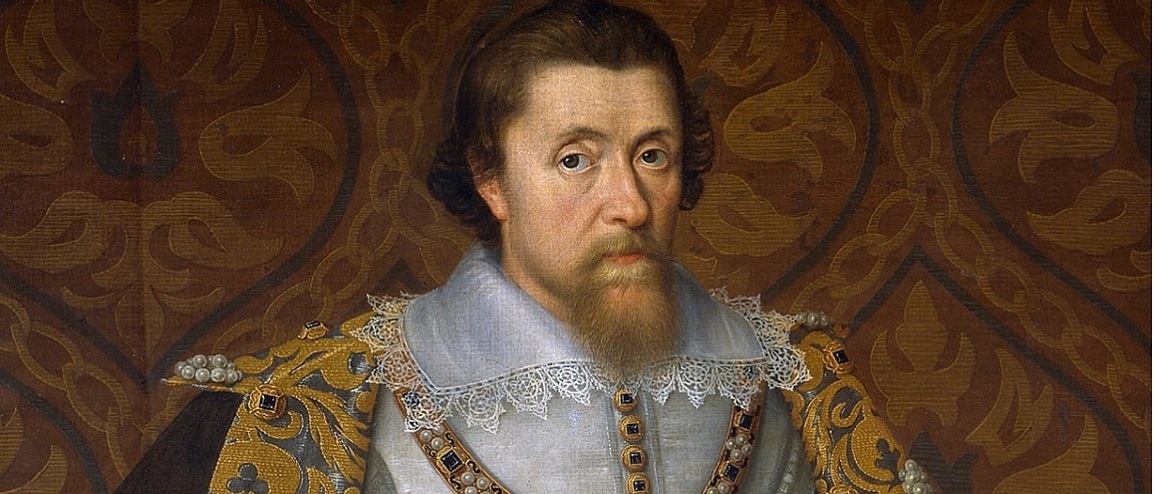James I of England
Posted on 20th January 2023
James was born on 19 June 1566 at Edinburgh Castle, Scotland, the only son of Mary, Queen of Scots and her second husband Henry Stuart, Lord Darnley.
When James was only one year old his mother Mary, Queen of Scots was forced to abdicate her throne in favour of him, and James was crowned King James VI of Scotland on 24 July 1567 at Stirling Castle, Scotland. He was never to see his mother again.
Being an infant, Scotland was ruled by a series of regents with many vying for the rule of Scotland. This led to James having an unsettled childhood being moved between guardians who all treated him differently, some good, others bad. He did however have an extensive education at which he excelled including Latin, French and Greek, also showing a passion for Literature.
James finally took control of his government in 1581 following the execution of his last regent. He was a popular ruler in Scotland, however even now he would still rely heavily on the influence of others.
In 1589 James married Anne of Denmark, the fourteen year-old daughter of Frederick II. Following a proxy marriage, Anne travelled to Scotland but storms at sea forced her to divert to Norway. James travelled out to Norway and they were married on 23 November 1589 at the Bishops Palace in Oslo, eventually returning to Scotland on 1 May 1590.
James and Anne’s marriage produced seven children with three surviving into adulthood.
Both Scotland and England were under threat of invasion from abroad and in 1586 James VI of Scotland and Elizabeth I of England agreed the Treaty of Berwick, whereby if either were invaded the other would provide aid.
In 1587 relations could have broken down following Elizabeth I’s decision to execute James’ mother, Mary Queen of Scots, however this act produced little protest from James.
James VI was very well educated and had a talent for writing. His published writings include The True Law of Free Monarchies in 1598, setting out the ‘Divine Right of Kings’, and Basilikon Doran in 1599.
James had been King of Scotland for over thirty years when he became King of England on 24 March 1603 following the death of Elizabeth I. He became the first ever King of both England and Scotland and saw himself as the King of Great Britain.
James travelled to London, his coronation taking place on 25 July 1603 at Westminster Abbey.
James made few changes in his early reign of England, keeping many of Elizabeth’s privy council members. The management of the government was overseen by Robert Cecil, later to become 1st Earl of Salisbury in 1605.
As King of Scotland James had never been at war with Spain, but knew that the threat of war was still there between Spain and England. James succeeded in negotiating the Treaty of London which was signed in 1604 finally ending the long Anglo-Spanish war.
There were still some in England wishing to return the country to the Catholic faith and James was to survive an assassination attempt in 1605, better know now as the Gunpowder Plot, to blow up both King and Parliament.
James is remembered for commissioning the translation of the bible into English in 1604. In 1611 this became known as the authorised King James I bible.
James was a lavish spender with little thought of the governmental debt this caused, he even sold off feudal lands to supplement his spending. Robert Cecil proposed that parliament should vote the King an annual fixed-sum allowance, becoming known as the ‘Great Contract’. James could not agree to this and dissolved the parliament in December 1610.
Robert Cecil died in 1612 and James I was never to have such an experienced minister again.
Parliament was recalled in 1614, but again agreement could not be reached and this was dissolved after only nine weeks. This became known as the ‘Addled parliament’.
In 1618, what was to become known as the ‘Thirty Years War’ began. James was not keen on war and tried to minimise England’s contribution to it.
James recalled parliament in 1621, but later dissolved it again. Summoning parliament for the final time in 1624, they still failed to reach an agreement on foreign policy.
By this time James’ health had deteriorated badly. He suffered from arthritis, gout and kidney stones. He was never to return to London.
James I died on 27 March 1625 at Theobalds House in Hertfordshire, his favourite hunting lodge. He is buried at Westminster Abbey.
Tagged as: Junior Stuarts
Share this post:





